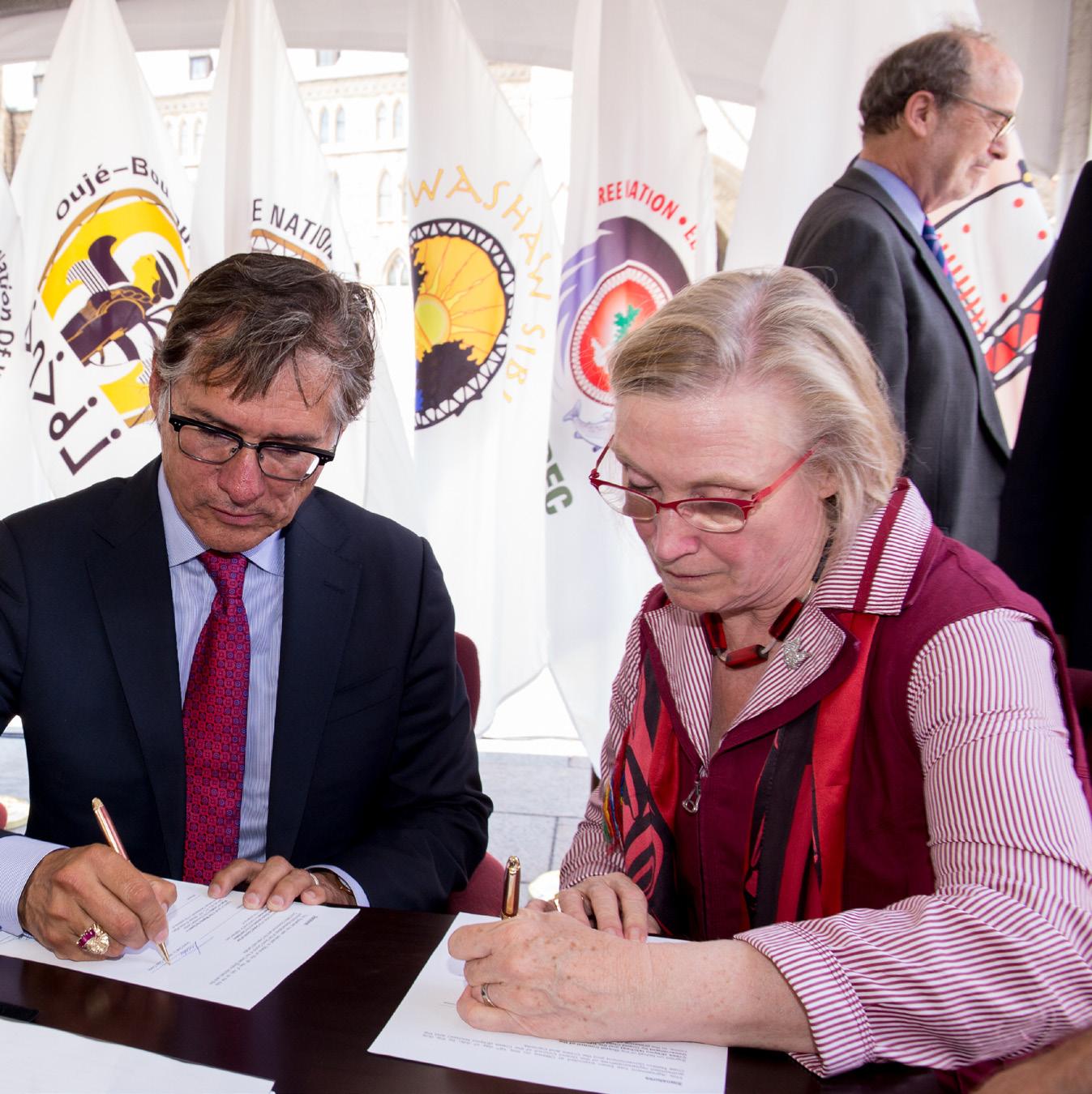
6 minute read
WE ARE HIRING
CCDC - AT THE HEART OF THE COMMUNITY
Founded in 1976, Cree Construction and Development Company, Ltd. is the first Canadian company owned by First Nations to earn and maintain ISO certification from the International Organization for Standardization.
Advertisement
Today, with more than 45 years of experience and expertise, Cree Construction and Development Company, Ltd. is the largest Cree-owned company in Canada. Operating primarily in northern Quebec, the company is fully owned by the Nine Cree Nations of James Bay.
Job Opportunities
To complete our team, we are looking for new members to fill certain positions:
Buyer
Construction estimator
Financial Director Project Manager
Office clerk
Surveyor
Foreman
Truck driver Employees for the concrete plant, asphalt plant, crushing plant
Electrician Plumber
For more information...
Call us: 450-661-1102, ext. 216 or 514-249-3539 ccdc.qc.ca
Come visit us: 3, Aahppisaach in Chisasibi.
Changes may soon be coming to the Cree constitution, which was enacted alongside a governance agreement with Canada in 2017 to advance Cree self-determination in Eeyou Istchee.
“We will be engaging with the communities in the fall to do a tour talking about the governance review we’re doing, asking for community participation in personalizing, enhancing and further developing the constitution,” Grand Chief Mandy Gull-Masty told the Nation
Former Grand Chief Matthew Coon Come signed the Agreement on Cree Nation Governance on July 18, 2017, and called it “reconciliation in action.” It provided jurisdiction to independently create laws and more efficiently govern Category 1A lands without being bound by the Cree-Naskapi Act, a federal statute adopted in 1984. It also provides the Cree power to collect their own taxes, although there is no obligation to use it.

While the governance agreement removed federal oversight on those lands and provided long-term stability by defining financial arrangements with Canada until 2040, rules regarding internal governance were moved from the CreeNaskapi Act into the Cree constitution.
“Our constitution sets out a basic framework of Cree values and procedures that will continue to evolve to incorporate distinctive Cree forms of governance,” Coon Come stated at the time. “This is a key development, for our constitution is not subject to the consent or approval of Canada or Quebec. It is a purely internal Cree document; one we can amend ourselves alone.”
The Cree constitution begins with an affirmation of Cree fundamental values and principles before outlining how laws, resolutions, meetings, elections and fiscal manage- ment are to be administered. It states that provisions in the James Bay and Northern Quebec Agreement, Governance Agreement and Act respecting the Cree Nation Government take precedence in the case of inconsistency or conflict.
Governance negotiations stemmed from the 2008 New Relationship Agreement and there were many differences to resolve over eight years. Coon Come said the approximately 80 major agreements signed with Canada, Quebec and industry since the JBNQA “tell the story of the long Cree struggle to make our vision of self-government and self-determination a reality.”
The constitution’s adoption was not without controversy. Community consultations often went long into the evening as people voiced their concerns and tried to understand the proposed changes. Women leaders such as Linda Shecapio and Irene Neeposh highlighted the panel leading consultations included no women.
Waskaganish Chief Darlene Cheechoo questioned why it was presented as a complete document and whether feedback would be taken into consideration. A petition with over 70 names asked for a delay, and Waskaganish was the last
Constitutional change
Amendments to Cree legal foundation on the horizon
by Patrick Quinn, Local Journalism Initiative Reporter
community to vote on the proposed initiatives.
When the constitution was approved, Gull-Masty was deputy chief of Waswanipi and abstained from voting on the motion to approve the draft documents. Her comments at the time foreshadowed recent developments to reopen these discussions.
“As a leader you are there to build the consensus amongst the communities,” said Gull-Masty in 2017. “I’m almost a little bit ashamed to say, [there is] bullying at this table.”
The constitution states that amendments can be initiated by a resolution adopted by CNG council. Upon adoption of this resolution, an amendment can be drafted and widely publicized. Approval and ratification require consent from each Cree Nation community.
The process of creating Indigenous constitutions has gained momentum across Canada over the past 20 years as they are viewed federally as an important part of any negotiations around self-governance. Constitutions generally clarify governing structures, leadership selection processes, and accountability and transparency mechanisms.

As alternatives to the Indian Act, they sometimes serve the role of formaliz- ing oral traditions, customs and laws. If developed under treaties, they may be shaped by preceding requirements that set basic standards for elected representatives, band membership and conflict of interest rules.
However, there remains legal debate about whether most of these constitutions have the same authority as federal legislation and raise the possibility of court battles if they come in conflict with Canadian laws. Some suggest their legitimacy could draw from an inherent Indigenous right to self-govern.
Other First Nations will be watching the Cree Nation’s proposed developments to its constitution. Since the JBNQA became the country’s first modern treaty, the Cree Nation has established a unique governance model that established a precedent for Indigenous autonomy.
“We have to pass on the tradition that the Crees are trailblazers, not followers,” asserted former CNG executive director Bill Namagoose in 2017. “We don’t have anybody in front of us to show us where to go. The Crees are trailblazers and will continue to be.”


Inuit Elders take healing journey
In late July, 15 Inuit Elders made a healing journey from Nunavik to a former sanatorium site in Hamilton, Ontario, where they had been held in the 1950s and 1960s.
About 1,200 Inuit were shipped to Hamilton’s sanatorium for tuberculosis treatment as part of a colonial policy that Prime Minister Justin Trudeau apologized for in 2019. Separated from their families, they were confined to beds and often endured psychological abuse.
During that time, Hamilton’s Sanatorium on the Mountain was home to the largest yearround community of Inuit anywhere in the country. Isolated from their language and culture, many Inuit lived there for years with their families having no knowledge of where they’d gone, or if they’d died.
The Elders also visited Hamilton’s Woodland Cemetery, where a monument honours the 37 Inuit known to have died at the sanatorium. The legacy of this colonial intervention is distrust in the medical system and an Inuit community that is nearly 300 times more likely to contract tuberculosis than the Canadian average.
Indigenous patients underwent invasive chest surgery and drug treatment at sanatoriums and “Indian hospi- tals” because they weren’t seen as capable of managing their condition at home like non-Indigenous patients. There are several accounts of Indigenous children being victims of medical experiments without their consent as many were physically restrained in their beds.
As tuberculosis treatment began to change in the 1940s from extensive bed rest to effective antimicrobial medications, sanatoriums across the country began emptying out.
The non-profit organization SeeChange Initiative helped Nunavut Tunngavik Inc. organize the trip, which was preceded by healing workshops. Naomi Tatty works for SeeChange and helped organize the trip for her 80-yearold mother, Ida Atagoyuk, whose baby was taken into foster care for three-and-ahalf years while Atagoyuk was kept in the sanatorium from age 21.
“They’ve long awaited this,” Tatty said. “Their emotions are building up. My sister wasn’t used to being around Inuit. She had lost her language and they couldn’t communicate with each other. They were both traumatized.”
Columbian pressure
It might seem like a small thing to complain about a name, but Concordia University student
Ray Coelho says the name of Christophe-Colomb Avenue in Montreal is just plain wrong. The street is named after the Spanish explorer Christopher Columbus, who was called the discoverer of the Americas after landing on the shores of a Caribbean island in 1492.
“It bothers me to see another colonial figure who subjugated the Native people of this hemisphere be celebrated with statues and street names,” Coelho said. “A street name is basically giving them prominence. I don’t think we should give prominence to someone like Christopher Columbus and his legacy.”
Coelho is going door to door along the street asking people to sign his petition. Along the way he talks to people about Columbus’ legacy of rape, torture, executions and enslavement of Indigenous peoples.
He has almost 200 signatures and is looking to get at least 1,000. The petition suggests restoring the street’s previous name to Des Ormes Boulevard, or “Elms” in English.
Montreal has bowed to public pressure in the past. In 2019, the city changed the name of Amherst Street to Atateken, a Mohawk word meaning equality or fraternity. It was originally named after British General Jeffery Amherst, who was notorious for being a pioneer in biological warfare by distributing smallpox-infested blankets to Indigenous people.
The petition represents a change of outlook for Coelho, who ran for the neo-Nazi National Party in the 2019 federal election, finishing last in the Lac-St-Louis riding with 28 votes. He now regrets his association with the openly racist and fascist group.
Compensation deal finally approved
The polar bear population in Canada is being significantly affected by climate change, particularly in relation to the availability of sea ice.
Hudson Bay, an important habitat for polar bears, experiences a complete freeze-over in winter and becomes icefree during the summer and autumn months. However, the timing and extent of ice breakup and freeze-up are changing due to rising temperatures.
In June 2023, warm weather caused accelerated ice breakup in Hudson Bay, leaving much of the bay with less ice than usual. As a result, polar bears are returning to land earlier, with some bears still on the diminishing ice despite the limited availability.
These changes in ice dynamics pose challenges for polar bears’ access to food, reproduction, and overall survival. Scientists warn that a longer ice-free season and reduced sea ice threaten the sustainability of the polar bear population in the region.







